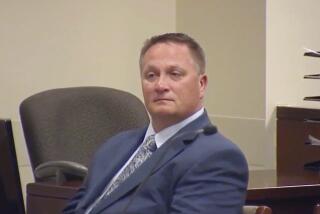A Dental Sedation Death Casts Doubt on Procedure
- Share via
Call it irrational, but Doreen Safier would choose pain over general anesthesia.
So great is her lifelong phobia that, rather than be “put under” when she goes to the dentist, Safier hums the 1812 Overture to distract her from the procedure.
Safier’s children did not inherit this fear, however. So when 27-year-old Jodi Safier was due to have four wisdom teeth extracted last fall, she agreed to light anesthesia.
At 2:30 p.m. on Sept. 4, Jodi Safier arrived for her appointment. Later that same afternoon she left the West Hollywood dentist’s office in an ambulance, comatose. Safier was declared dead five days later at Cedar’s-Sinai Medical Center. The autopsy report listed the cause of death as “cardiac arrest during fentanyl and Valium anesthesia for dental extraction.”
Jodi Safier apparently was the victim of a procedure called conscious sedation, a form of anesthesia that produces a slightly depressed level of consciousness in a patient who remains awake and capable of carrying on a conversation. The same drugs used to effect conscious sedation are administered in general anesthesia, only in greater amounts.
On rare occasions, a patient under conscious sedation may descend by degrees into a state of general anesthesia, or even further into death. In the last three years, at least 12 Californians have died from the procedure, according to the state Board of Dental Examiners.
It’s likely that there have been others. “We often don’t even hear about these cases,” said Los Angeles Deputy Dist. Atty. Robert Dawson. Dawson’s office is investigating the Safier death and, in an unrelated case, has filed involuntary manslaughter charges against a South-Central Los Angeles dentist and nurse anesthetist in the death of 3-year-old Johnny Gray following a conscious sedation procedure in 1984.
California is one of 22 states that do not regulate the use of conscious sedation. (There is a bill in the California Legislature that would set educational standards for dentists using the technique.) Dentists interviewed for this story agreed that when administered properly, conscious sedation holds little risk. The concern among many, however, is that dentists with inadequate training may not be equipped to save a life in the case of an overdose.
Some of those health-care professionals who use the technique in their practices are amply qualified, with as much as two years’ training in anesthesia techniques. (The Board of Dental Examiners in Sacramento said a conservative estimate would be that 1,000 of the 20,000 dentists in the state use the method.) At the other end of the spectrum are practitioners who may have received no formal training in conscious sedation, said Richard DeCuir of the dental board.
Attempts to regulate the procedure have been bogged down for several years as various factions within the dental community debate just what sort of regulations are acceptable to them. Some providers object, for instance, to the suggestion that dentists should have a second trained party on hand to monitor a patient’s vital signs during dental procedures. The cost of this, they say, would be unmanageable.
Doreen Safier and her husband Ron hope that Jodi’s story will bring a greater sense of urgency to the debate and spur the passage of the conscious sedation bill currently pending in the state Legislature.
The Menlo Park couple talked about their crusade recently while visiting Los Angeles for the unveiling ceremony at Jodi’s grave.
Ron Safier said of the ceremony: “Theoretically, in our religion (the Safiers are Jewish), the unveiling is supposed to be the time when you stop mourning. But it doesn’t really work that way.”
After she graduated from college, dark-haired Jodi Safier wanted to try for Hollywood. “She wanted to be a movie star, she really did,” Ron Safier said.
Her father agreed to support her for two years while she auditioned for roles, but after the two years were up and stardom was no closer, Ron Safier advised good-naturedly, “Jodi, get a job.”
Jodi went to work as a room clerk at the Chateau Marmont Hotel (she had a degree in restaurant and hotel management from Cal Poly Pomona) and eventually promoted to director of marketing.
When she wasn’t working, she liked to go horseback riding at the equestrian center across from the Mt. Sinai Memorial Park where she would later be buried.
Every six to eight weeks, Jodi’s parents flew down from Menlo Park to visit. The last time they came was last year, just before last Labor Day weekend.
Knowing that Jodi had dental work scheduled for later that week, her parents quizzed her about the dentist she would be seeing. Shouldn’t she really be going to an oral surgeon? they asked. But Jodi assured them it would be a simple extraction; the wisdom teeth were straight and non-impacted.
While Jodi was still at the dentist on that September afternoon, her younger brother Jon, then a UCLA student, bought a dozen roses and took them to Jodi’s West Hollywood apartment to cheer her recovery. (The other Safier sibling, Shari Caspert, 26, lives in New York.)
Then Jon telephoned the dentist to see if Jodi was ready to be picked up.
There was no answer. Perplexed, Jon put down the phone. A few minutes later, a woman called him from the dentist’s office. “There’s been an accident and your sister was taken to Cedars-Sinai,” she said.
The dentist, William Miller, declined a request from The Times to discuss the events leading up to Jodi Safier’s death. The following account of what went on in Miller’s office that afternoon is taken from the coroner’s report and a declaration the Safiers filed with the state Board of Dental Examiners:
Miller administered the drug fentanyl on two occasions and Valium. He changed the intravenous tube when he saw it was bruising Jodi’s arm. While extracting the first tooth, he noticed unusually dark blood, and he commented to his nurse about it. (Miller would later tell the Safiers that the dark color indicated a low oxygen level in Jodi’s blood.)
As he performed the third extraction, Miller glanced at Jodi’s throat area and saw that she was struggling to breathe. He took her pulse and it was faint. He administered Narcan, hoping to reverse the effects of the sedation, and asked his nurse to call the paramedics.
By the time the paramedics arrived, Jodi was in a coma; her heart had stopped beating. The emergency medical crew restarted her heart and took her to Cedars-Sinai emergency room. She never regained consciousness.
Safier’s dentist is being investigated by the state Board of Dental Examiners, which has the power to revoke his license to practice.
Dr. Gary Sugarman, the cardiologist who saw Jodi at Cedars-Sinai, said in a telephone interview that the amount of anesthetic Safier apparently was given was “a very substantial dose.”
Sugarman said Safier’s death seemed to be related to the anesthesia, and not a pre-existing condition.
“As far as we knew, she was otherwise healthy,” he said.
Conscious sedation is a deceptive term. While most people have some understanding of the dangers that can accompany general anesthesia, conscious sedation sounds more like a harmless metaphysical technique than what it actually is: a baby step on the way to general anesthesia.
Because it sounds innocuous, patients may assume that any dentist is qualified to safely use the method.
But for now, and until legislation is passed regulating conscious sedation, it’s up to each patient to look out for himself or herself.
That doesn’t mean abstaining completely from dental anesthesia like Doreen Safier; it simply means knowing which questions to ask.
Leland Reeve, president of the California Assn. of Oral and Maxillofacial Surgeons, suggests that patients inquire if their dentist has credentialed training in the anesthetic procedure he or she is going to use. It’s important to know if the dentist has resuscitative equipment in the office, and if the staff is drilled and trained in emergency life-saving procedures, he said.
Sen. Joseph Montoya (D-Whittier) has introduced legislation that would take the burden off the patient by insuring that every dentist who uses conscious sedation is fully qualified to do so. As explained by Montoya aide Amiel Jaramillo, the legislation would require practitioners to receive 120 hours of training in the technique. Under the new regulations, dentists would be responsible for continuously monitoring the vital signs of a patient under conscious sedation.
Furthermore, they would be under compulsion to report any mishaps or deaths involving the procedure to the dental board. (Currently, no one organization keeps records of deaths occurring in dental offices, Jaramillo explained.)
The Safiers are devoting a good portion of their lives these days to seeing that the legislation is passed.
They feel that the enactment of a conscious sedation bill would accomplish what the unveiling ceremony was supposed to do--allow them to stop mourning.
More to Read
Sign up for Essential California
The most important California stories and recommendations in your inbox every morning.
You may occasionally receive promotional content from the Los Angeles Times.
![Vista, California-Apri 2, 2025-Hours after undergoing dental surgery a 9-year-old girl was found unresponsive in her home, officials are investigating what caused her death. On March 18, Silvanna Moreno was placed under anesthesia for a dental surgery at Dreamtime Dentistry, a dental facility that "strive[s] to be the premier office for sedation dentistry in Vitsa, CA. (Google Maps)](https://ca-times.brightspotcdn.com/dims4/default/8c153ef/2147483647/strip/true/crop/2010x1344+32+0/resize/320x214!/quality/75/?url=https%3A%2F%2Fcalifornia-times-brightspot.s3.amazonaws.com%2F78%2Ffd%2F9bbf9b62489fa209f9c67df2e472%2Fla-me-dreamtime-dentist-01.jpg)









